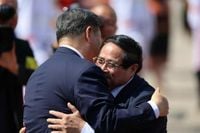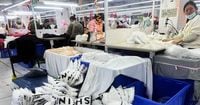In a significant diplomatic move, Chinese President Xi Jinping visited Vietnam on April 14 and 15, 2025, stirring considerable reactions in both nations and beyond. This visit comes at a time of heightened tensions between the United States and its trading partners, particularly amid President Donald Trump’s aggressive tariff policies.
During Xi’s visit, Trump reportedly expressed concerns, stating that "China and Vietnam are meeting to explore ways to harm the United States." This assertion has undoubtedly cast a shadow over Vietnam's relationship with the U.S., complicating an already delicate diplomatic landscape. Vietnam finds itself perplexed, caught between the economic ambitions of China and the looming threats posed by U.S. tariffs.
As Trump threatens to impose a staggering 46% tariff on imports from Vietnam, the Vietnamese government is seeking to negotiate a review of tariffs, proposing to eliminate all import tariffs on goods coming from the U.S. However, the reality is stark; Vietnam imports relatively few goods from the U.S., meaning that such concessions would not significantly alleviate the trade deficit faced by the United States.
Meanwhile, the repercussions of Trump's tariffs are being felt far beyond Vietnam. The rapid rise of SHEIN, a Chinese online fast fashion retailer, has had a profound impact on local economies, particularly in villages surrounding Guangzhou. These villages, now referred to as 'Shein villages,' have become synonymous with the company’s explosive growth, which has seen it sell over $30 billion worth of goods annually.
SHEIN's success is attributed to its low-price strategy and the exploitation of the de minimis rule, which allows for duty-free imports into the U.S. This has enabled the company to thrive in an environment where traditional manufacturing costs are rising. However, a recent visit to these villages revealed a somber atmosphere among factory owners and suppliers. Many reported a decrease in orders from SHEIN, largely due to the company's shift in production towards Vietnam.
Factory owner Mr. Lee, who has been manufacturing clothing for both domestic and overseas markets since 2006, noted a dramatic 50% drop in orders from SHEIN this year. He attributed this decline to SHEIN's increased orders to Vietnam, stating, "The impact is clear. Tariffs are imminent, it's unclear when they will end, and it's unclear what will happen next."
As the Trump administration's tariff policies continue to shake the foundations of international trade, SHEIN's operations are also under scrutiny. The company is reportedly encouraging its main suppliers to consider opening factories in Vietnam, a move that could mitigate the financial impact of U.S. tariffs. Mr. Foo, another factory owner and SHEIN supplier, confirmed that since the Trump administration took office, the company has been urging major factories to explore production opportunities in Vietnam.
However, this shift is not without its challenges. While increasing sourcing from Vietnam may allow SHEIN to benefit from lower tariffs, there is no guarantee that the de minimis rule will remain applicable for goods shipped from Vietnam. This uncertainty creates a dilemma for the company, as it must balance cost and delivery time while adapting its business model.
Professor Shen Lu from the University of Delaware emphasized the need for SHEIN to diversify its supply chain while simultaneously overhauling its business model. He pointed out that without significant changes, SHEIN may struggle to maintain its competitive edge in a rapidly evolving market. The company must find ways to produce small quantities of a vast array of styles quickly and efficiently, or risk losing its foothold.
Alison Leahy, a product development director at EPOST GLOBAL, echoed these sentiments, noting that while SHEIN’s business model is innovative, a complete shift could impact delivery times and costs. She warned that if SHEIN attempts to pass increased costs onto consumers, it may face a backlash, as customers are unlikely to purchase at previous volumes and prices.
For Mr. Lee, the prospect of moving production to Vietnam is less than appealing. The necessary investment in new equipment, coupled with lower labor productivity in Vietnam compared to China, makes the transition daunting. He remarked, "In China, we can finish 10,000 clothes in one day, but in Vietnam, it takes a month." This stark contrast highlights the complexities surrounding the potential relocation of manufacturing operations.
As Vietnam navigates its position in this evolving landscape, Prime Minister Ishiba is set to visit Vietnam and the Philippines during the first half of Golden Week, aiming to bolster security cooperation with China in mind. The discussions will likely involve an exchange of views on the implications of Trump’s tariffs, further underscoring the interconnectedness of global trade dynamics.
In conclusion, the unfolding events surrounding Xi Jinping's visit to Vietnam and the ramifications of SHEIN's production strategies reveal the intricate web of international relations and economic policies at play. As countries grapple with the challenges posed by tariffs and shifting production landscapes, the future of trade in the region remains uncertain.






